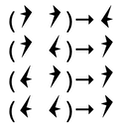The Inner Mind
[Similar introductory presentation here]
Philosophy of mind has the problem of "mental privacy" or "the problem of first-person perspective." It's a problem because philosophers can't account for how the first person view of consciousness might be possible. The answer has been known for the last 100 years or so and has a very simple physical explanation. We know how to build a system that has a private first person experience.
Let us use two distinguishable physical objects:

These shapes of these objects are arbitrary and were chosen so as not to represent something that might have meaning due to familiarity. While they have rotational symmetry, this is for convenience for something that is not related to the problem of mental privacy.
Next, let us build a physical device that takes two of these objects as input and selects one for output. Parenthesis will be used to group the inputs and an arrow will terminate with the selected output. The device will operate according to these four rules:

A network of these devices can be built such that the output of one device can be used as input to another device.
It is physically impossible to tell whether this device is acting as a NAND gate or as a NOR gate. We are taught that a NAND gate maps (T T)→F, (T F)→T, (F T)→T, and (F F)→T; (1 1)→0, (1 0)→1, (0 1)→1, (0 0)→0 and that a NOR gate maps (T T)→F, (T F)→F, (F T)→F, (F F)→T; (1 1)→0, (1 0)→0, (0 1)→0, (0 0)→1. But these traditional mappings obscure the fact that the symbols are arbitrary. The only thing that matters is the behavior of the symbols in a device and the network constructed from the devices. Because you cannot tell via external inspection what the device is doing you cannot tell via external inspection what the network of devices is doing. All an external observer sees is the passage of arbitrary objects through a network.1
To further complicate the situation, computation uses the symbol/value distinction: this symbol has that value. But "value" is just elements of the alphabet and so are identical to symbols when viewed externally. That means that to fully understand what a network is doing, you have to discern whether a symbol is being used as a symbol or as a value. But this requires inner knowledge of what the network is doing, which leads to infinite regress. You have to know what the network is doing on the inside to understand what the network is doing from the outside.
Or the network has to tell you what it's doing. NAND and NOR gates are universal logic gates which can be used to construct a "universal" computing device.2
So we can construct a device which can respond to the question "what logic gate was used in your construction?"
Depending on how it was constructed, its response might be:
- "I am made of NAND gates."
- "I am made of NOR gates."
- "I am made of NAND and NOR gates. My designer wasn't consistent throughout."
- "I don't know."
- "What's a logic gate?"
- "For the answer, deposit 500 bitcoin in my wallet."
Before the output device is connected to the system so that the answer can be communicated, there is no way for an external observer to know what the answer will be.
All an external observer has to go on is what the device communicates to that observer, whether by speech or some other behavior.3
And even when the output device is active and the observer receives the message, the observer cannot tell whether the answer given corresponds to how the system was actually constructed.
So extrospection cannot reveal what is happening "inside" the circuit. But note that introspection cannot reveal what is happening "outside" the circuit. The observer doesn't know what the circuit is doing; the subject doesn't know how it was built. It may think it does, but it has no way to tell.
[1] Technology has advanced to the point where brain signals can be interpreted by machine, e.g. here. But this is because these machines are trained by matching a person's speech to the corresponding brain signals. Without this training step, the device wouldn't work. Because our brains are similar, it's likely possible that a speaking person could train such a machine for a non-vocal person.
[2] I put universal in quotes because a universal Turing machine requires infinite memory and this would require an infinite number of gates. Our brains don't have an infinite number of neurons.
[3] See also Quss, Redux, since this has direct bearing on yet another problem that confounds philosophers, but not engineers.

